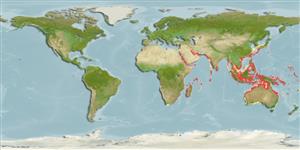Common names from other countries
Environment: milieu / climate zone / depth range / distribution range
Écologie
marin; profondeur 1 - 50 m (Ref. 122825). Subtropical; 30°N - 33°S, 28°E - 179°E
Indo-Pacific: from East London, South Africa to Iraq, east to Fiji. Mediterranean: Lessepsian migrant.
Length at first maturity / Taille / Poids / Âge
Maturity: Lm 19.3 range ? - ? cm
Max length : 32.2 cm TL mâle / non sexé; (Ref. 94840)
Épines dorsales (Total): 6; Rayons mous dorsaux (Total): 9-10; Épines anales 2; Rayons mous anaux: 9. Dusky band from snout through center of eye and above pectoral base to caudal peduncle, the band may be yellowish on the head; caudal fin yellow, upper and trailing edge black (Ref. 5491).
Minimum depth from Ref. 122826.
Life cycle and mating behavior
Maturité | Reproduction | Frai | Œufs | Fécondité | Larves
De Sylva, D.P. and F. Williams, 1986. Sphyraenidae. p. 721-726. In M.M. Smith and P.C. Heemstra (eds.) Smiths' sea fishes. Springer-Verlag, Berlin. (Ref. 5491)
Statut dans la liste rouge de l'IUCN (Ref. 130435)
CITES (Ref. 128078)
Not Evaluated
Menace pour l'homme
Harmless
Utilisations par l'homme
Plus d'informations
RéférencesAquacultureProfil d'aquacultureSouchesGénétiqueElectrophoresesHéritabilitéPathologiesTraitementMass conversion
Outils
Articles particuliers
Télécharger en XML
Sources Internet
Estimates based on models
Preferred temperature (Ref.
115969): 24.4 - 29.1, mean 27.7 (based on 612 cells).
Phylogenetic diversity index (Ref.
82804): PD
50 = 0.5000 [Uniqueness, from 0.5 = low to 2.0 = high].
Bayesian length-weight: a=0.00661 (0.00544 - 0.00803), b=2.91 (2.87 - 2.95), in cm Total Length, based on LWR estimates for this species (Ref.
93245).
Niveau trophique (Ref.
69278): 3.9 ±0.7 se; based on size and trophs of closest relatives
Résilience (Ref.
120179): Haut, temps minimum de doublement de population inférieur à 15 mois (Preliminary K or Fecundity.).
Fishing Vulnerability (Ref.
59153): Low vulnerability (24 of 100).
